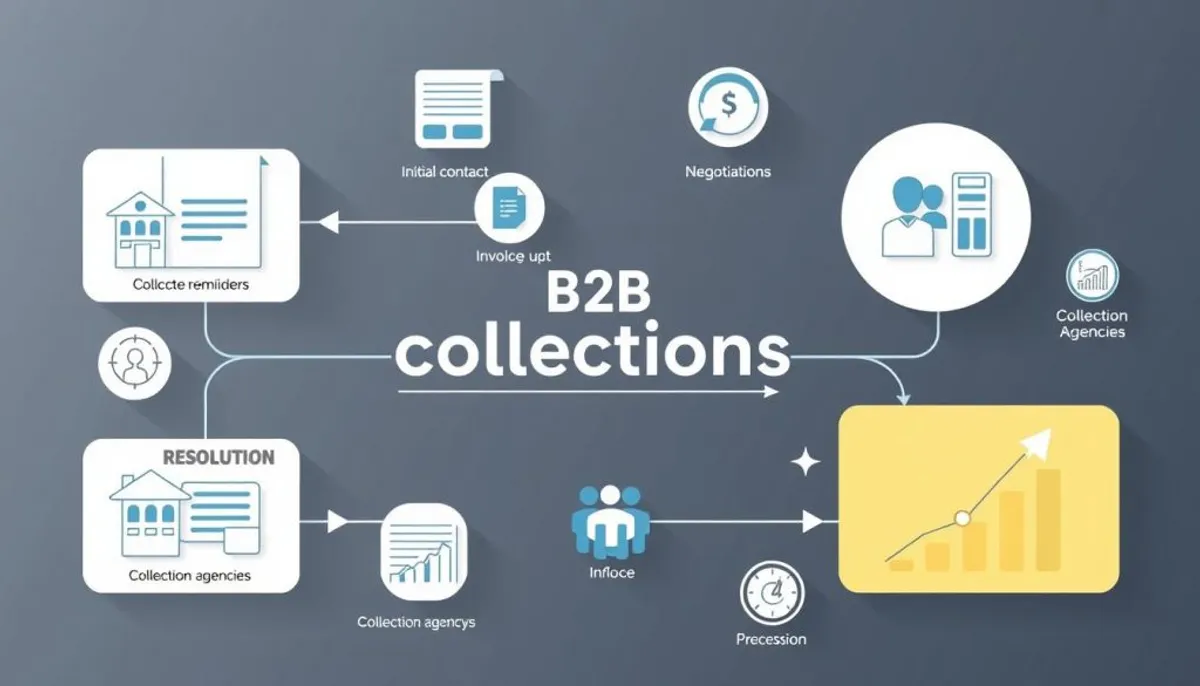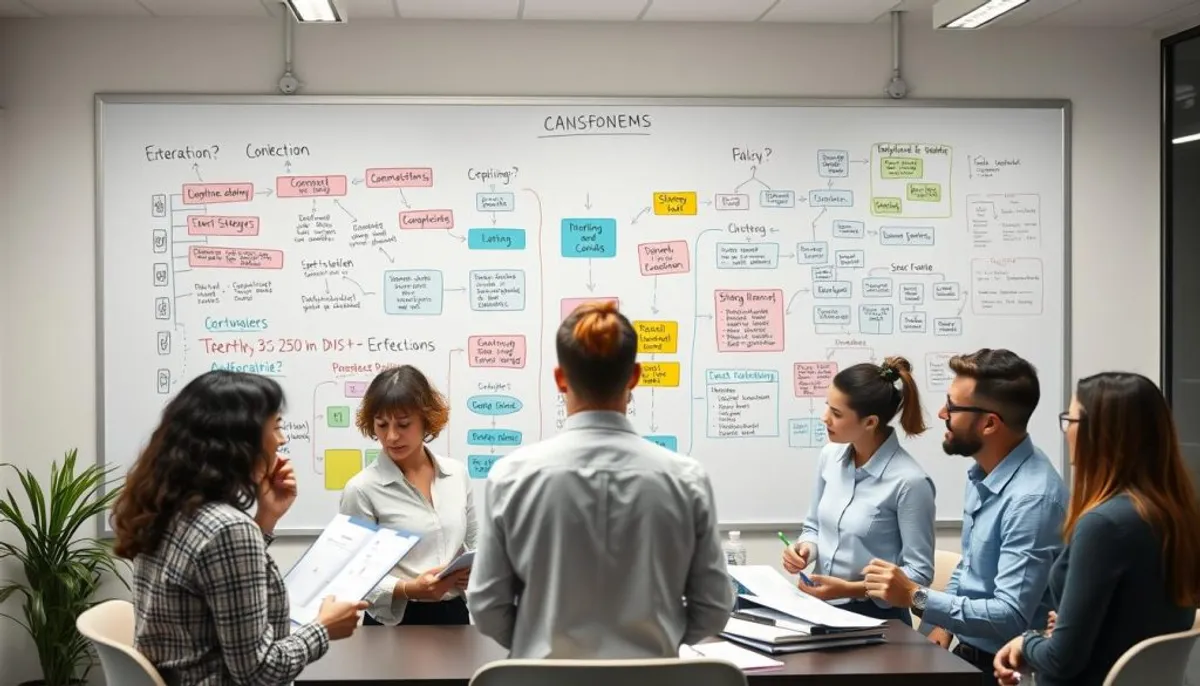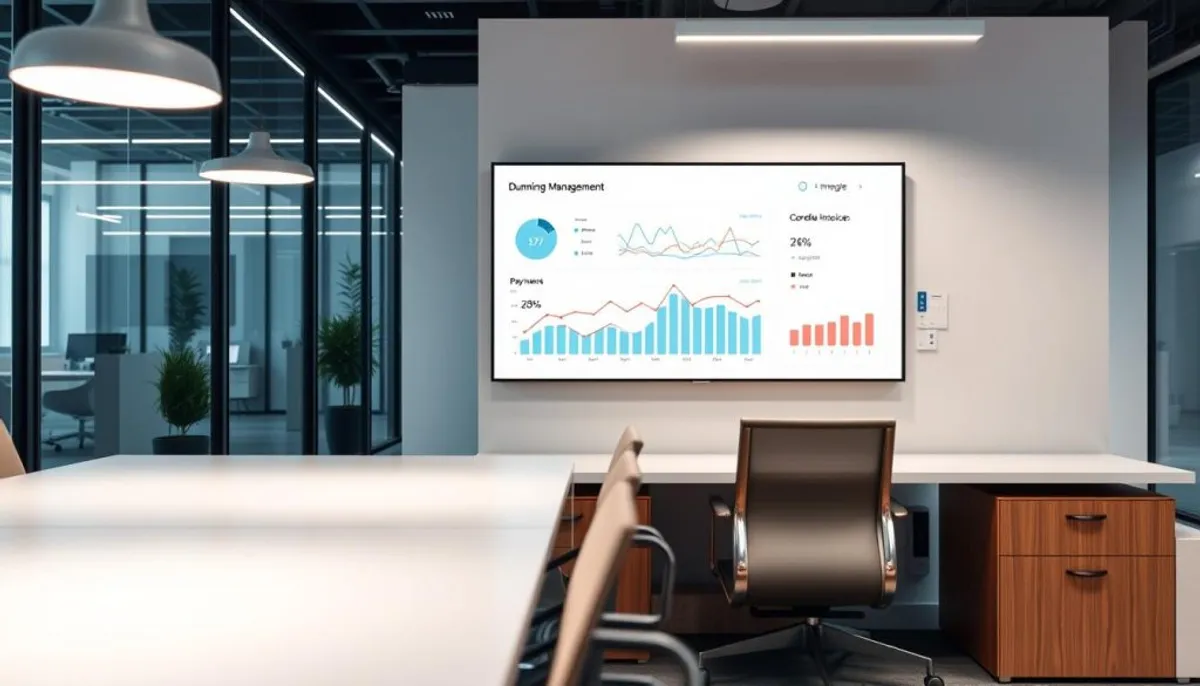In the realm of business-to-business transactions, the management of accounts receivable is paramount to financial stability. B2B collections are instrumental in sustaining cash flow and cultivating robust business relationships. This guide delves into the complexities of managing accounts receivable within the B2B sector.
The B2B industry is characterized by longer business cycles and distinct credit systems. Unlike consumer collections, B2B transactions involve substantial sums and intricate agreements. This complexity highlights the necessity of a meticulously designed collections process. It is essential for addressing overdue payments in a professional and efficient manner.

Implementing effective b2b collections strategies is vital for ensuring timely payments and fostering positive business relationships. Establishing clear payment terms, communication protocols, and escalation procedures can prevent revenue loss and ensure operational continuity. The integration of automation tools and specialized software solutions can notably improve the efficiency of accounts receivable management.
Key Takeaways
- B2B collections involve larger transactions and complex agreements
- A well-structured collections process is crucial for timely payments
- Clear communication and documentation are essential in B2B collections
- Automation tools can streamline accounts receivable management
- Proactive approaches help prevent late payments and maintain relationships
- Understanding legal considerations is important in B2B collections
Understanding the Fundamentals of B2B Collections
B2B collections are essential for maintaining a business’s cash flow. They differ from consumer collections due to larger transactions and longer credit terms. This process demands a careful balance between recovering funds and maintaining business relationships.
What Sets B2B Collections Apart
B2B collections stand out from consumer collections in several ways. They involve escalating communication methods when initial reminders are ignored. Offering flexible payment plans can often resolve issues without harming business relationships. Professional agencies work on a contingency-fee basis, earning a percentage of the recovered amount.
The Impact on Business Relationships
The manner in which a company handles delinquent account recovery can greatly affect its reputation. In the interconnected B2B world, news spreads quickly. Adopting a customer-centric approach in collections can lead to higher retention rates and improved revenue recovery. Building strong relationships is crucial for effective B2B collections and can even transform challenging situations into opportunities for strengthening partnerships.
Key Stakeholders in the Collection Process
Several parties are crucial in B2B collections. The accounts receivable team manages daily transactions. Credit managers assess risks and set terms. Business owners make critical decisions about escalation. For companies facing numerous overdue accounts, hiring a specialized commercial debt collection agency can be advantageous. These agencies bring expertise, ensuring compliance with legal standards and freeing up internal resources for core business activities.
Building a Robust Accounts Receivable Management Strategy
A solid accounts receivable management strategy is crucial for maintaining healthy cash flow in businesses. By concentrating on credit and collections, companies can enhance their financial stability and operational efficiency.
Effective invoice collections begin with timely invoicing and consistent payment tracking. Utilizing automated systems simplifies payment reminders and escalation processes. This approach can cut down cash collection time by up to 80%.
Key performance indicators are essential for gauging the success of your strategy:
- Days Sales Outstanding (DSO): Aim for less than 30 days
- Average Days Delinquent (ADD): Track overdue payments
- Accounts Receivable Turnover Ratio: Assess cash flow
- Collection Effectiveness Index (CEI): Target close to 100%
To minimize overdue accounts, consider offering early payment discounts, such as 2% off for payment within ten days. Establishing flexible payment plans helps maintain good relationships while ensuring timely payments. Regularly follow up on unpaid invoices and consider debt recovery services for invoices over 30 days past due.
By adopting these strategies, businesses can safeguard professional relationships, expedite payments, and establish a robust accounts receivable management system. This system supports long-term financial health.
Essential Components of an Effective Collection Policy
A well-crafted collection policy is crucial for successful dunning management and revenue cycle optimization. Let’s explore the key elements that make up an effective strategy.
Establishing Clear Payment Terms
Clear payment terms form the foundation of a solid collection policy. Businesses should specify due dates, late fees, and the collections process in all contracts and communications. This transparency helps prevent misunderstandings and sets clear expectations for both parties.

Creating Communication Protocols
Effective communication is vital in B2B collections. A significant portion of clients prefer multi-channel communication, including emails, letters, and phone calls. Businesses should outline when and how to contact clients regarding payments. For instance:
- 15 days overdue: Send an email reminder
- 30 days overdue: Mail a physical letter
- 45 days overdue: Make a phone call
Developing Escalation Procedures
When initial collection efforts fail, having a clear escalation process is essential. This may include sending demand letters, applying penalties, or engaging collection agencies. Implementing late fees and offering incentives for prompt payment can encourage timely settlements.
| Policy Review Frequency | Percentage of Companies |
|---|---|
| Do not review regularly | 50% |
| Every 2 years | 19% |
| Every 3 years | 13% |
| When necessary | 15% |
| Other timeframes | 12% |
Regular review and adjustment of collection policies are crucial for maintaining effective dunning management and optimizing the revenue cycle. SMBs often neglect this important practice, potentially hindering their financial health.
Leveraging Technology in Collections Management
Technology has transformed the landscape of accounts receivable management and debt recovery services. Modern enterprises now employ advanced tools to streamline their collection processes. This not only boosts efficiency but also enhances overall performance.
Automation Tools and Software Solutions
Automation software has simplified tasks such as invoicing, payment tracking, and sending reminders. These tools minimize manual errors, allowing staff to focus on more complex cases. AI-powered platforms further enhance these capabilities by assessing creditworthiness, prioritizing accounts, and implementing targeted collection strategies.
Digital Payment Integration
Integrating digital payment options accelerates transactions and improves cash flow. Online portals enable customers to view invoices and make payments effortlessly. This user-friendly approach enhances their experience, encouraging timely settlements.
Data Analytics for Better Decision Making
Data analytics tools offer insights into payment patterns, aiding in informed decision-making. This includes setting credit limits and tailoring collection approaches. Predictive analytics can also identify customers at risk of non-payment, enabling proactive measures.
| Technology Benefits | Impact on Collections |
|---|---|
| Automation | Reduced operating costs, increased collection rates |
| AI Integration | Enhanced efficiency, improved accuracy in decision-making |
| Digital Communication | Improved customer experience, higher satisfaction rates |
By embracing these technological advancements, businesses can achieve remarkable results in debt recovery. This not only improves their financial health but also strengthens customer relationships.
Proactive Approaches to Prevent Late Payments
Businesses can adopt proactive measures to avert late payments in b2b collections. Clear communication stands as a cornerstone. Approximately 70% of enterprises that embed detailed payment instructions on invoices witness a rise in payment punctuality. This straightforward tactic significantly influences credit and collections endeavors.
Introducing early payment incentives is another potent strategy. Discounts for immediate payment foster goodwill and enhance cash flow. Offering diverse payment avenues, such as online transactions, credit cards, and wire transfers, facilitates timely payments.
Automation is indispensable in thwarting late payments. Automated reminders for impending due dates keep clients abreast. This systematic approach is essential for efficiently managing nonpaying clients.
- Send multi-channel reminders
- Offer flexible payment options
- Implement early payment incentives
- Use automated accounts receivable processes
Regular cash flow monitoring is crucial for identifying potential issues promptly. By scrutinizing payment patterns, businesses can pinpoint high-risk accounts and allocate resources effectively. This proactive stance in b2b collections minimizes bad debt losses and elevates customer satisfaction.
Lastly, establishing clear late payment policies ensures customer accountability. Transparent enforcement of these policies can yield compensation for collection efforts, promoting timely payments. It is imperative to periodically review and refine these strategies to maintain their efficacy in your credit and collections framework.
The Role of ti3 Platform in Modern B2B Collections
The ti3 platform is transforming B2B collections, offering a holistic solution for dunning management and revenue cycle optimization. It addresses the critical need for efficient collection processes, given that 87% of businesses struggle with delayed payments.
Automated Reminder Systems
Ti3’s automated reminder system simplifies the collection process. It dispatches timely, personalized reminders to clients, thus reducing the manual effort required by collection teams. This is essential, as 50% of invoices for design agencies are paid up to 60 days past the due date.
Customer Relationship Management Features
The platform’s CRM capabilities are designed to foster positive client relationships during collections. It enables businesses to track interactions, assign follow-up tasks, and manage client information efficiently. This approach is supported by research indicating that invoices with “thank you” in payment terms are settled 90% faster.

Payment Processing Integration
Ti3 integrates seamless payment processing, making transactions and reconciliation easier. This feature is crucial, as businesses offering diverse payment options experience faster settlements. The platform supports popular payment methods such as credit cards, digital payments, and bank transfers.
By adopting ti3, businesses can enhance their collection outcomes while preserving strong client relationships. The platform’s emphasis on automation and customer-centric features positions it as a cost-effective alternative to traditional debt collection agencies. This is critical, as 82% of small businesses fail due to cash flow issues.
Legal Considerations and Compliance in Collections
In the realm of commercial debt collection, grasping legal mandates is paramount. Transactions between businesses differ significantly from those with consumers. The absence of the Fair Debt Collection Practices Act in B2B dealings grants more latitude in collection strategies.
Understanding Collection Laws
B2B collections operate under fewer constraints than their B2C counterparts. This permits engagement with multiple stakeholders within an enterprise and the deployment of skip tracers. Yet, adherence to legal frameworks is imperative to circumvent potential conflicts. State-specific statutes may introduce additional complexities to your collection endeavors.
Documentation Requirements
Accurate documentation is fundamental in commercial debt collection. It is imperative to maintain comprehensive records of all interactions, invoices, and agreements. Such documentation acts as a bulwark against legal challenges and facilitates dispute resolution. It is crucial to have contracts that clearly delineate payment obligations and the repercussions of non-compliance.
Risk Management Strategies
Effective risk mitigation in business-to-business collections encompasses several key elements:
- Regular credit assessments on clients
- Establishment of suitable credit thresholds
- Defined protocols for escalating collection actions
- Comprehensive understanding of contractual stipulations and entitlements
By adopting these strategies, enterprises can significantly reduce the risks associated with unremitted invoices and preserve their financial health. It is crucial to remember that, despite the greater flexibility in B2B collections, upholding professional standards is vital for sustained success.
Maintaining Professional Relationships During Collections
In the realm of b2b collections, the preservation of professional relationships stands as a paramount concern. Effective accounts receivable management necessitates a delicate balance between debt recovery and the maintenance of business connections. This balance is achieved through clear communication and respectful interactions.
Initiating transparent terms and agreements from the outset is crucial in averting misunderstandings. Timely and accurate invoicing fosters trust and prevents payment delays. When disputes surface, offering flexible payment options demonstrates empathy, potentially enhancing recovery prospects.
Employing polite yet firm reminders aids in settling outstanding debts while upholding respect. A nuanced understanding of the debtor’s perspective enables the crafting of tailored communication strategies. Negotiation and settlement are indispensable for forging mutually beneficial solutions.
- Use mediation services for collaborative resolutions
- Consider debt recovery agencies as neutral third parties
- Ensure compliance with collection laws
- Train collection teams in effective communication
Professional agencies adeptly navigate sensitive situations, applying pressure without alienating debtors. This method facilitates amicable resolutions and enhances client retention. It is imperative to reserve legal action as a final resort, after exhausting all amicable avenues.
By prioritizing the maintenance of relationships during b2b collections, businesses can effectively recover debts while safeguarding valuable partnerships. This balanced approach to accounts receivable management is pivotal for long-term success within the B2B domain.
Conclusion
Effective b2b collections are vital for financial stability and cash flow optimization. The global debt collection services market is poised for growth, underscoring the need for specialized accounts receivable management. Implementing a structured collections process and leveraging technology can significantly enhance debt recovery services.
Automated cash management tools have demonstrated impressive results, reducing Days Sales Outstanding by 63% in just 12 months. This showcases the transformative impact of technology on b2b collections. Personalized communication strategies and thorough credit risk assessments have proven effective in minimizing late payments and preserving valuable client relationships.
Outsourcing collections to specialized agencies can lead to enhanced efficiency and improved cash flow. These agencies employ advanced techniques, customized strategies, and customer-centric practices to optimize b2b collections. As the industry evolves, businesses must adapt their collection strategies to meet new challenges, ensuring long-term success in accounts receivable management.
RelatedRelated articles



